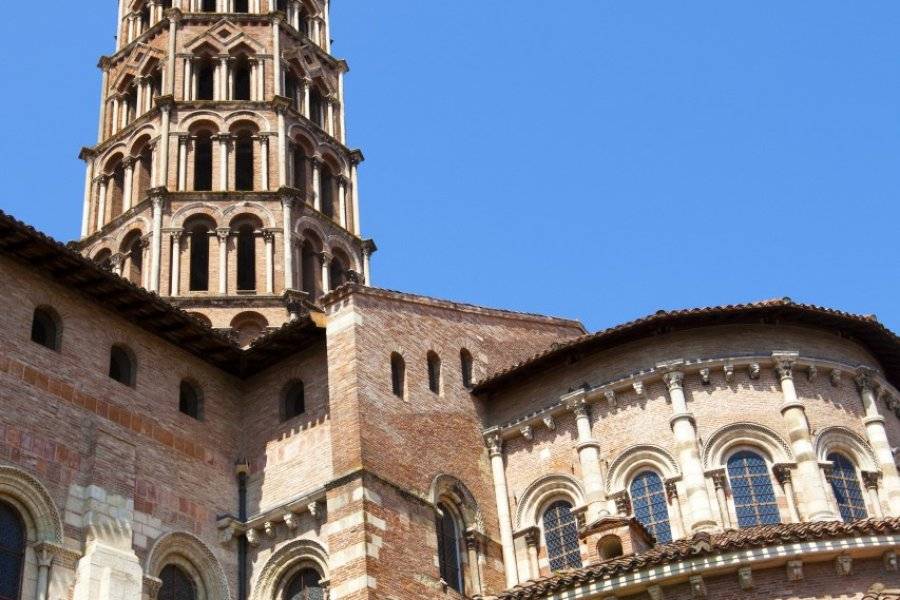The Saint-Sernin basilica is considered the largest Romanesque church in existence. Unesco-listed Pilgrim's Way to Santiago de Compostela.
A remnant of an ancient collegiate enclosure, the basilica, a UNESCO World Heritage site, is considered the largest Romanesque church in existence. Its size and beauty continue to fascinate, just as Stendhal was when he visited in 1838. The church is 115 m long, 64 m wide at transept level (which gives it its Latin cross shape), 20 m high under its barrel vault, divided into twelve bays by double arches and supported by tribunes, a central nave with double aisles, an ambulatory and radiating chapels, all of which illustrate an architecture adapted to the traffic of pilgrims on their way to Compostela, who came to venerate numerous relics, including those of Saint Saturnin.
For it all began with the story of the town's first bishop, Saturnin or Sernin in Occitan, martyred in 250 AD. The legend, written in the5th century, recounts how the Romans sacrificed him to the gods, tying him to a bull that roamed the entire ancient city before abandoning the body outside the city walls at the site of the Notre-Dame-du-Taur church, the first burial place for his relics. The name of the street linking the two buildings, taur, meaning "bull", bears witness to this event. A new basilica was built in the5th century on the site of the present one, as it had become too small. The crypt was built into the apse of this first building. Work on the Romanesque church began around 1070, and by 1096 the chevet and walls up to the west portal were complete. Pope Urban II consecrated the building that year when he visited Toulouse to preach the start of the First Crusade. Construction was completed in the mid-13th century. Restoration was undertaken by Viollet-le-Duc in 1860, resumed in 1990 and embellished with the pedestrianization of the forecourt in 2019.
The " Tour des corps saints " is open to visitors. The ambulatory and crypt housed 175 different relics. Worth seeing: the sumptuous 17th-century reliquaries, the remains of the Romanesque altar base: Christ in Majesty and angels, cherubim and seraphim, by sculptor Bernard Gilduin, as well as the altar table (a visible copy) still in place in the choir, or the sculptures on theMiègeville door (dating from 1100) depicting the Ascension of Christ (tympanum) and the Witness Apostles (lintel).
Some 700 capitals adorn the columns, some of them historiated, others decorated with plant or animal motifs. These can be seen outside, notably at the Porte des Comtes (south transept, parable of Lazarus and the rich man), or inside in the tribunes (only accessible to volunteers from Saint-Sernin) and at the chevet.
Romanesque paintings can still be seen on some walls (north transept, cycle of the Passion and Resurrection of Christ (1180)), and Renaissance paintings (choir dated 1535-1550, Christ in glory).
The Baroque baldachin, designed in 1718-1759 by Marc Arcis, houses the tomb of Saint Sernin.
The great organs of the Saint-Sernin basilica, completed in 1889 by Cavaillé-Coll, are world-renowned. The instrument has fifty-four stops on three manuals and a pedalboard (exactly 3,458 pipes). Concerts.
The bell tower rises 65 m above the transept crossing, and its carillon plays the Ave Maria de Lourdes hymn every hour.
At the end of 2024, the stained glass window in the large rose on the west façade was inaugurated. A masterpiece by artist Jean-Michel Othoniel (5.50m in diameter), it was created in collaboration with master glassmakers from Ateliers Loire, Chartres.
Did you know? This review was written by our professional authors.
Members' reviews on SAN BERNARDO BASILICA
The ratings and reviews below reflect the subjective opinions of members and not the opinion of The Little Witty.











